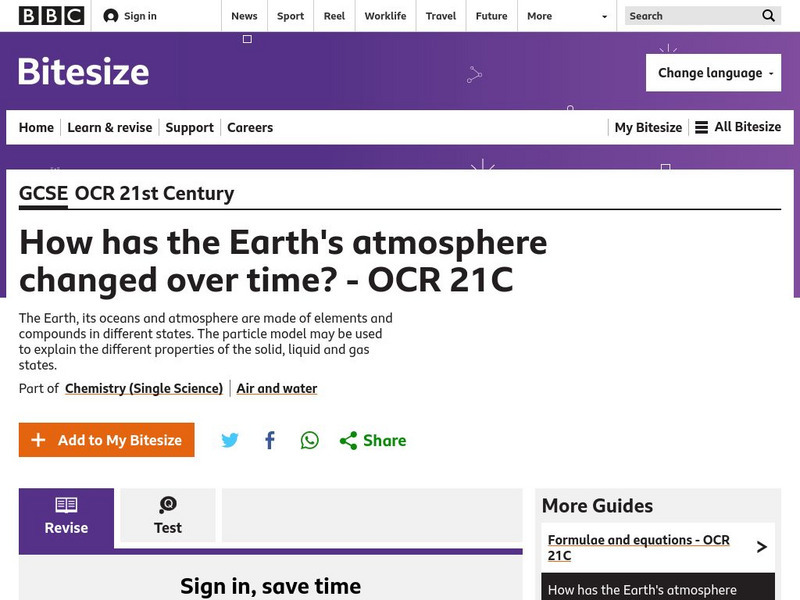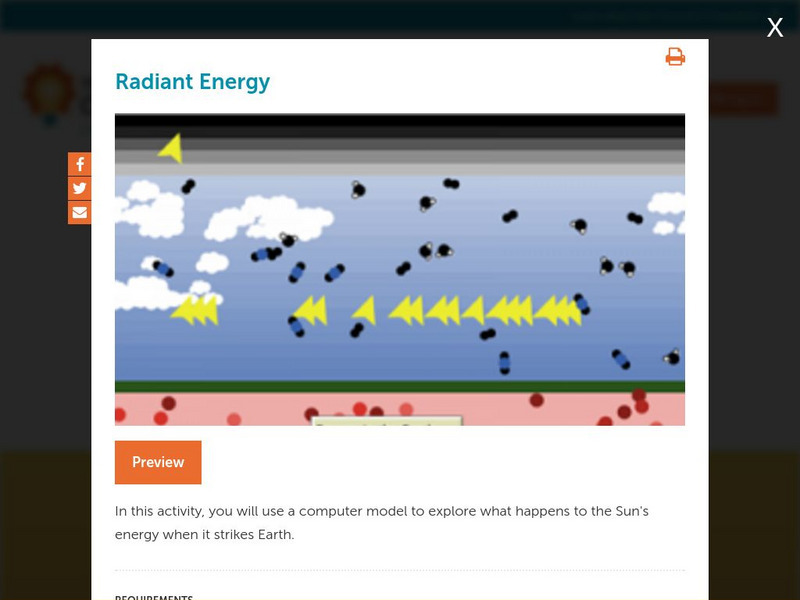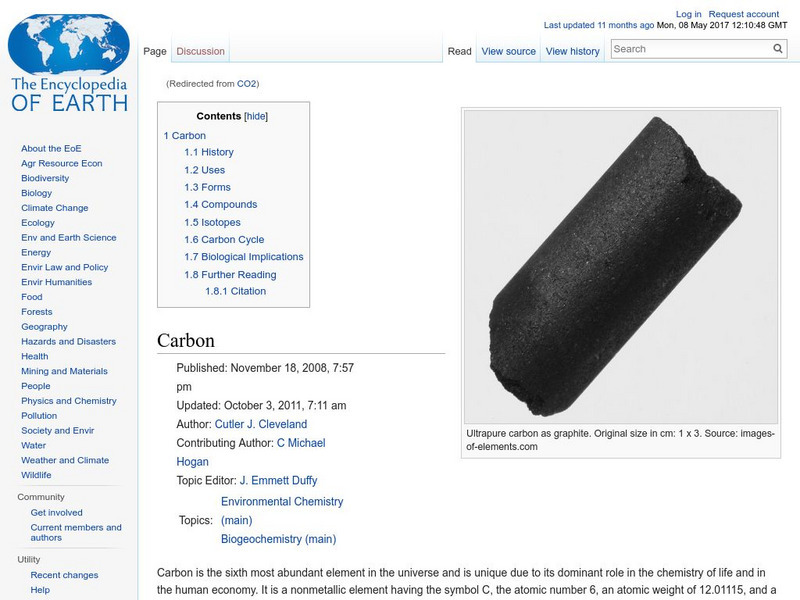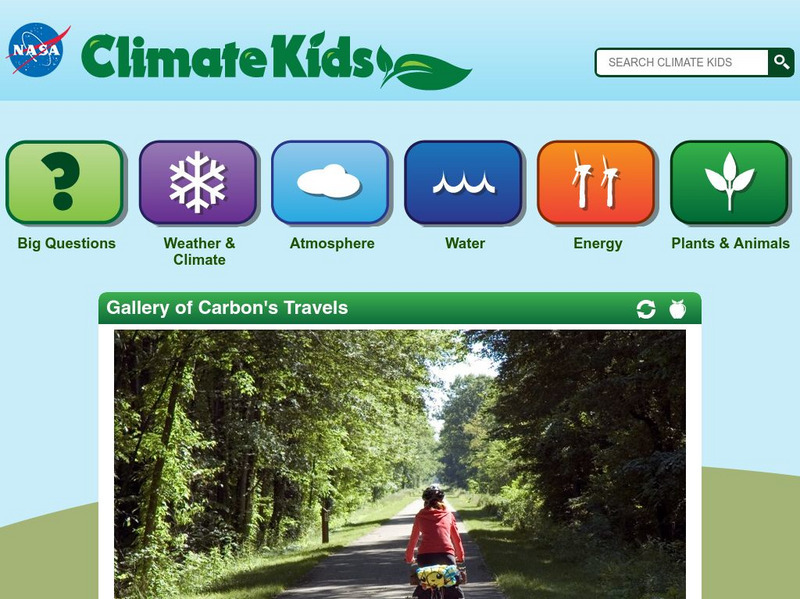Hi, what do you want to do?
BBC
Bbc: Gcse Bitesize: How Has the Earth's Atmosphere Changed Over Time? Ocr 21 C
This lesson focuses on ways to reduce air pollution from power stations and from automobiles. It provides a link to an assessment.
Concord Consortium
Concord Consortium: Stem Resources: Radiant Energy Flow
A virtual lab to look at the physical features of Earth that affect the amount of the Sun's energy that hits Earth. Students investigate how solar and infrared radiations enters and leaves the atmosphere with this model. Virtual lab...
Encyclopedia of Earth
Encyclopedia of Earth: Physics & Chemistry: Carbon Dioxide
Explains what carbon dioxide is, where it is found, sources of it, and describes human activities that contribute to carbon depletion and increased levels of carbon dioxide in the atmosphere. (Updated: February 22, 2013)
University Corporation for Atmospheric Research
Ucar: The Greenhouse Effect
Students will learn how greenhouse gases temporarily trap heat within Earth's atmosphere, warming the planet via the greenhouse effect.
North Central Regional Educational Laboratory
Kids Learn: Respiratory System Internet Workshop
Come and explore this internet workshop that was designed to introduce you to a study on the respiratory system. Students and teachers will benefit from this resource.
University Corporation for Atmospheric Research
Ucar: What Do Soda and the Oceans Have in Common?
Students will use soda to explore how carbon dioxide is able to dissolve into liquid. They will learn about Henry's law, which describes how the solubility of gas into liquids is dependent on temperature and develop hypotheses about how...
University Corporation for Atmospheric Research
Ucar: Climate Sensitivity Calculator
This simple calculator allows you to play around with the relationship between atmospheric CO2 concentration and average global temperatures. This is called climate sensitivity.
Energy4Me
Energy4me: Carbon Footprint
After completing the first part of this activity, students will be able to explain individual carbon footprints and list the means for reducing them. The second part of this activity helps students to visualize climate as a system with...
University Corporation for Atmospheric Research
Ucar: Carbon Dioxide
Learn all about Carbon Dioxide, an important constituent of our planet's air playing an important role in Earth's carbon cycle and photosynthesis.
University Corporation for Atmospheric Research
Ucar: The Carbon Cycle
A comprehensive introduction to the carbon cycle. The cycle of atoms between living and non-living things is known as a biogeochemical cycle. The most common of these are the carbon and nitrogen cycles.
National Earth Science Teachers Association
Windows to the Universe: Biogeochemical Cycles
Biogeochemical cycles happen when individual elements are recycled over and over in different parts of the Earth. Two examples are the Nitrogen Cycle and Carbon Cycle. Read an explanation of biogeochemical cycles and view a diagram of...
PBS
Pbs Learning Media: Understanding Air: Climate Change and Modeling Combustion
In this lesson, students learn about the components of air and the chemical reactions that release carbon dioxide into the atmosphere and explore the connection between carbon dioxide, climate change, and environmental health.
Utah Education Network
Uen: Co2 in Car Exhaust
Students will investigate the carbon dioxide content in different types of cars.
CK-12 Foundation
Ck 12: Life Science: 12.17 Cellular Respiration and Photosynthesis
Explore the two complementary processes of photosynthesis and cellular respiration.
CK-12 Foundation
Ck 12: Earth Science: Carbon Cycle and Climate Study Guide
Review the relationship between the carbon cycle and climate.
Exploratorium
Exploratorium: Ice Stories: Dispatches From Polar Scientists: Greenhouse Gases
Polar scientists offer an article identifying the research and observations made on greenhouse gases. Why is there so much carbon dioxide in the atmosphere today? Scientists work diligently to determine the causes and effects of these...
PBS
Greenhouse Green Planet
Why is the earth just the right temperature to support life? The answer is the greenhouse effect, and you can learn more about it using this resource.
NASA
Space Math: Nasa Satellite "Sees" Carbon Dioxide [Pdf]
Using this map from NASA you can calculate the concentrations of carbon dioxide in the atmosphere. Solve the four problems and you will see how concentrations are spread across the globe and where there are regional differences.
The Franklin Institute
The Franklin Institute Online: Greenhouse Effect in a Jar
Students can investigate the greenhouse effect on the atmosphere with this simple lesson. The steps are easy and the materials needed are basic.
NASA
Nasa: Climate Kids: Gallery of Carbon's Travels
A collection of images which shows the effects of too much carbon in our atmosphere There are also some promising carbon-reducing images as well.
TeachEngineering
Teach Engineering: Carbon Cycles
Students are introduced to the concept of energy cycles by learning about the carbon cycle. They will learn how carbon atoms travel through the geological (ancient) carbon cycle and the biological/physical carbon cycle. Students will...
Other
Rocky Mountain Institute: Climate Protection for Fun & Profit [Pdf]
The first article in this newsletter talks about a speech made by Former President Bill Clinton and his stance on the environment. (Published 1997)
University Corporation for Atmospheric Research
Ucar: Learn: The Greenhouse Effect
A detailed overview of the greenhouse effect, with explanations about Earth's atmosphere gases referred to as greenhouse gases, and the factors that influence the heat-trapping ability of a greenhouse. All information is reinforced...
University Corporation for Atmospheric Research
Ucar: Co2: How Much Do You Spew?
Students analyze the energy consumption of a hypothetical household to determine the amount of carbon dioxide they are adding to the atmosphere each year.















